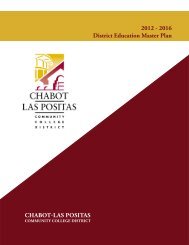City College of San Francisco - California Competes
City College of San Francisco - California Competes
City College of San Francisco - California Competes
You also want an ePaper? Increase the reach of your titles
YUMPU automatically turns print PDFs into web optimized ePapers that Google loves.
HISTORY OF CITY COLLEGE<br />
As <strong>of</strong> 2005, <strong>City</strong> <strong>College</strong> <strong>of</strong> <strong>San</strong> <strong>Francisco</strong> has<br />
served the educational needs <strong>of</strong> its city for 70<br />
years. During that time, the <strong>College</strong> has evolved<br />
into a multicultural, multi-campus community<br />
college that is one <strong>of</strong> the largest in the country.<br />
The <strong>College</strong> was founded in response to a<br />
demand from the citizens for a public institution<br />
to serve both the academic and the vocational<br />
needs <strong>of</strong> students as an integral part <strong>of</strong> the <strong>San</strong><br />
<strong>Francisco</strong> Unified School District. It was first<br />
housed in temporary facilities at the University<br />
<strong>of</strong> <strong>California</strong> Extension Division building and at<br />
Galileo High School. Classes began on September<br />
1,1935 with an enrollment <strong>of</strong> 1,074 students<br />
and 74 faculty members. The enrollment rapidly<br />
increased, and, four years later, the <strong>College</strong><br />
was holding classes in 22 locations. The <strong>San</strong><br />
<strong>Francisco</strong> Board <strong>of</strong> Education approved a building<br />
plan for the <strong>College</strong> in 1937, which included<br />
a 56-acre site bordering Balboa Park at Phelan<br />
Avenue. The 1937 ground-breaking ceremony,<br />
conducted by Mayor Angelo Rossi, led to the<br />
1940 opening <strong>of</strong> the Science Hall and the North<br />
and South Gymnasiums to approximately 3,200<br />
students.<br />
The once steadily growing enrollment was<br />
reversed when the United States entered World<br />
War II; however, the <strong>College</strong> provided educational<br />
training to the Army and Navy personnel. By<br />
1947, the enrollment was on the rise again as<br />
returning veterans joined high school graduates<br />
pursuing their college degrees. To provide sufficient<br />
classroom space, the <strong>College</strong> acquired the<br />
adjoining U.S. Navy WAVES Separation Center<br />
across Phelan Ave., used Excelsior School as an<br />
annex, and scheduled its first evening classes.<br />
Federal and State grants and the passage <strong>of</strong> a<br />
school bond issue made funds available for the<br />
<strong>College</strong> to continue its building program. Cloud<br />
Hall was completed in 1954, Smith Hall in 1955,<br />
the Creative Arts Building and the Track and<br />
Field in 1961, Statler Wing in 1964, the<br />
Horticulture Center in 1965, and the Visual Arts<br />
Building and the Student Union in 1970.<br />
In 1970, the <strong>College</strong> was separated from the<br />
<strong>San</strong> <strong>Francisco</strong> Unified School District, and a new<br />
entity, the <strong>San</strong> <strong>Francisco</strong> Community <strong>College</strong><br />
District, was formed. This new entity included<br />
not only the <strong>College</strong> but also the Adult and<br />
Occupational Education Division <strong>of</strong> the unified<br />
district. Responding to the expressed community<br />
need, the <strong>College</strong> maintained these neighborhood<br />
education programs composed primarily<br />
<strong>of</strong> noncredit courses. Because <strong>of</strong> rapid growth,<br />
the <strong>College</strong> subsequently formed two separate<br />
divisions: one for credit courses located on the<br />
Balboa Park (Ocean) Campus; and one for noncredit<br />
courses <strong>of</strong>fered throughout the <strong>City</strong>, under<br />
the umbrella <strong>of</strong> the <strong>San</strong> <strong>Francisco</strong> Community<br />
<strong>College</strong> District. This growth was also accompanied<br />
by additional building. The Arts Extension<br />
was completed in 1972, Conlan Hall in 1974,<br />
and Batmale Hall and the Downtown Campus<br />
in 1978.<br />
The two divisions were merged in 1990, and<br />
a single <strong>City</strong> <strong>College</strong> <strong>of</strong> <strong>San</strong> <strong>Francisco</strong>, <strong>of</strong>fering<br />
both credit and noncredit courses at 12<br />
campuses and nearly 200 neighborhood sites,<br />
was created. The 12 campuses are Alemany,<br />
Castro/Valencia, Chinatown/North Beach,<br />
Downtown, Evans, Fort Mason, John Adams,<br />
Mission, Ocean, and Southeast. The <strong>College</strong><br />
employs more than 700 full-time and 1,100<br />
part-time faculty. Ninety-five (95) percent <strong>of</strong><br />
faculty and administrators hold master’s degrees<br />
and approximately 200 hold doctorates.<br />
They teach over 98,000 credit and noncredit<br />
students annually.<br />
The <strong>College</strong> adopted its first Strategic Plan in<br />
December 1997. The two-year process had broad<br />
participation from the <strong>College</strong> and the community<br />
and produced strategies and action plans in<br />
six major goal areas. Also in 1997 (June), a $50<br />
million school bond measure was passed which<br />
paved the way for significant facilities upgrades.<br />
CITY COLLEGE OF SAN FRANCISCO<br />
1







